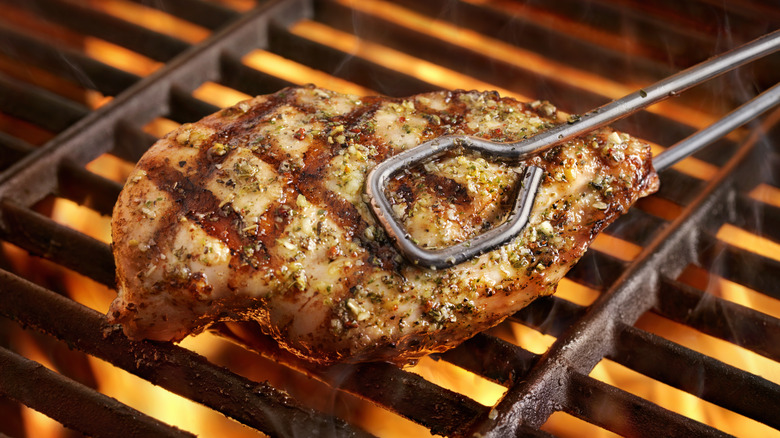Ina Garten Says It's Okay To Undercook Chicken For The Juiciest Results
Don't get your feathers in a twist. When The Barefoot Contessa says it's okay to undercook chicken, she isn't suggesting anyone should actually eat undercooked chicken. Instead, she's simply saying that pulling the poultry off the heat when it's still a few points shy of the 165-degree Fahrenheit safety rule will ensure the final product isn't overcooked. "Cook the chicken with the skin on, undercook it slightly, and let it rest (and keep cooking) under a sheet of aluminum foil," Garten explained in her Instagram series, "Ask Ina." "You won't believe what a difference this makes!"
After years of perfecting her chicken recipes, Garten came to the conclusion that one of the best ways to avoid overcooking chicken — and ultimately serving guests dried-out, rubbery poultry — is to embrace a process known as carryover cooking. This method involves bringing the chicken to just under the recommended internal temperature of 165 degrees Fahrenheit, then pulling it off the heat and letting it rest for around 10 minutes. The chicken will continue cooking — without a heat source. It's a process experienced chefs employ all the time — and they're doing it in plain sight. Don't believe us? How many times have you watched a grill master expertly cook a steak and then pull it off the heat to let it rest before serving? That resting part? It's just another term for carryover cooking.
Ready to dig in?
Applying the concept of carryover cooking to chicken is anything but a hit-or-miss kitchen trick. It's the embodiment of a scientific principle known as the second law of thermodynamics. Hang on to your oven mitts, it's not nearly as high-brow as it sounds. Simply put, the second law of thermodynamics explains that heat transfer is a one-way street; heat always flows from high to low. When it comes to cooking chicken, that means the higher heat on the outside of the meat will always migrate toward internal, cooler, points in the protein — even after it's removed from the oven. Of course, there's a limit. Eventually, the entire portion of chicken will begin to cool. So how close is close enough when it comes to reaching the right almost-there temperature? That depends on the cut of your chicken.
In general, plan to let your chicken rest for five to 10 minutes before serving. The internal temperature of a whole roast chicken can rise as much as 10 degrees while it's resting while the carry-over cooked temperature of a chicken breast usually tops out at five degrees. But there's a caveat. Knowledge of how carryover cooking works comes in handy in the kitchen — it's especially useful for navigating the fine line between just-right and overcooked chicken — but, it's not a replacement for a good meat thermometer. Always, without fail, use a thermometer to check the internal temperature of the chicken before serving.

